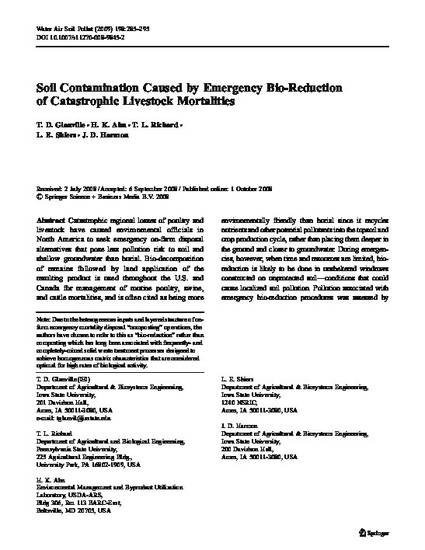
Catastrophic regional losses of poultry and livestock have caused environmental officials in North America to seek emergency on-farm disposal alternatives that pose less pollution risk to soil and shallow groundwater than burial. Bio-decomposition of remains followed by land application of the resulting product is used throughout the U.S. and Canada for management of routine poultry, swine, and cattle mortalities, and is often cited as being more environmentally friendly than burial since it recycles nutrients and other potential pollutants into the topsoil and crop production cycle, rather than placing them deeper in the ground and closer to groundwater. During emergencies, however, when time and resources are limited, bio-reduction is likely to be done in unsheltered windrows constructed on unprotected soil—conditions that could cause localized soil pollution. Pollution associated with emergency bio-reduction procedures was assessed by comparing pre- and post-bio-reduction concentrations in soil beneath the bio-reduction sites. Small but statistically significant (p < 0.05) increases in chloride at depths of 1.2 m indicated that bio-reduction leachate reached this depth. Significant increases in % total nitrogen and % total carbon were observed only in the top 15 cm of soil, but large increases in total ammonia–nitrogen were observed at depths of 30–90 cm. The total mass of N added to soil by bio-reduction was 10–25% of the estimated total N in the cattle carcasses, indicating that bio-reduction poses a lower pollution threat to soil and shallow groundwater than burial.
Available at: http://works.bepress.com/thomas_glanville/34/

This article is from Water, Air and Soil Pollution 198, no. 1–4 (March 2009): 285–295, doi:10.1007/s11270-008-9845-2.